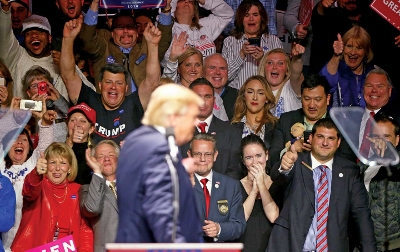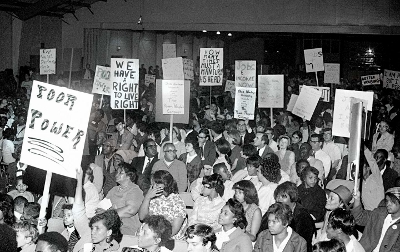Trumpism: It’s Coming From the Suburbs

Throughout the 2016 campaign, amid the shock of its results, and in the various recapitulations of its lessons, great swaths of the mainstream and liberal press have been consistent about whom they blame for Donald Trump and his ultra-right-wing administration: the white working class. “That’s what Trump is playing to,” The New Yorker’s George Packer told NPR’s Terry Gross days before the election. “It’s a really dangerous, volatile game, but that’s…maybe the biggest story of this election.” In the weeks after the election, liberal-hotshot-of-yesteryear Markos Moulitsas found it appropriate to crow over retired coal miners losing their health coverage from his swanky office in Berkeley, California (median home value: $1,080,400). Even today, the contempt remains obvious: Self-appointed “resistance” leader and actual flag-wearer Keith Olbermann could find no better way to insult his fellow multimillionaires Sarah Palin, Kid Rock, and Ted Nugent than by calling them “trailer park trash.”
Even according to pundits on the traditional right, one can find the reason for Trump’s success festering in lower-income white communities, the enemies of racial and social progress, where reactionary politics and redneck racism run rampant. “The white American underclass,” according to National Review’s Kevin D. Williamson, “is in thrall to a vicious, selfish culture whose main products are misery and used heroin needles. Donald Trump’s speeches make them feel good. So does OxyContin.” According to this analysis, Trump’s fascism is merely a reflection of the debased preferences of poor people.
But scapegoating poor whites keeps the conversation away from fascism’s real base: the petite bourgeoisie. This is a piece of jargon used mostly by Marxists to denote small-property owners, whose nearest equivalents these days may be the “upper middle class” or “small-business owners.” FiveThirtyEight reported last May that “the median household income of a Trump voter so far in the primaries is about $72,000,” or roughly 130 percent of the national median. Trump’s real base, the actual backbone of fascism, isn’t poor and working-class voters, but middle-class and affluent whites. Often self-employed, possessed of a retirement account and a home as a nest egg, this is the stratum taken in by Horatio Alger stories. They can envision playing the market well enough to become the next Trump. They haven’t won “big-league,” but they’ve won enough to be invested in the hierarchy they aspire to climb. If only America were made great again, they could become the haute bourgeoisie—the storied “1 percent.”
Trump’s most institutionally entrenched middle-class base includes police and Border Patrol unions, whom he promptly unleashed after his inauguration by allowing them free rein in enforcing his vague but terrifying immigration orders, and by appointing an attorney general who would call off investigations into troubled police departments. As wanton as their human-rights atrocities in the years leading up to the Trump era have been, law-enforcement agents are already making their earlier conduct look like a model of restraint. They are Trump’s most passionate supporters and make concrete his contempt for anyone not white, male, and rich.

Always and everywhere, this sort of petit bourgeois constitutes the core of fascism. In The Mass Psychology of Fascism, his look at the German economy and ideology in the five years preceding Adolf Hitler’s rise to power, Wilhelm Reich argued that this was largely because of the petite bourgeoisie’s dependence on the patriarchal family unit, which he called the “central reactionary germ cell” of “the authoritarian state.” As the “heads” of their families, small-business-owning men often exploited their wives and children and enforced a patriarchal morality on them in the interest of protecting their somewhat vulnerable enterprises. This oriented the petite bourgeoisie structurally toward reactionary politics.
If the petit-bourgeois American suburbs embody a sexist hierarchy, they exist in order to enforce a racist one. In the mid-20th century, white northern and western urbanites faced a choice: Stay in the cities where Jim Crow was driving a “Great Migration” of millions of black people, or flee to the new suburban residential developments, complete with racist exclusionary charters. The Federal Housing Administration made the choice easy: Its policy redlined neighborhoods where black people were settling as having low “residential security,” thus making financial services inaccessible. In white-only suburban communities, however, the FHA was pleased to guarantee home mortgages. “There goes the neighborhood,” said millions, and fled.
Their material security bound up in the value of their real-estate assets, suburban white people had powerful incentives to keep their neighborhoods white. Just by their very proximity, black people would make their neighborhoods less desirable to future white home-buyers, thereby depreciating the value of the location. Location being the first rule of real estate, suburban homeowners nurtured racist attitudes, while deluding themselves that they weren’t excluding black people for reasons beyond their pocketbooks.
In recent decades, rising urban rents have been pushing lower-income people to more peripheral locations. As suburbia has grown poorer, the more affluent homeowners have fled for the even greener pastures of exurbia. Everywhere they turn, their economic anxiety follows them.
And yet, “among people I talk to, ‘economic anxiety’ has become kind of a joke slogan,” New York Times columnist Paul Krugman told CNN’s Christiane Amanpour, by way of explaining Trump’s rise. “I mean, there is real economic hardship. West Virginia is not a happy place. But…it’s really mostly about race.” Krugman and Amanpour’s seamless transition from “anxiety” to “hardship” betrays the assumption that haunted the entire discussion: that the only form of economic anxiety is deprivation. To the contrary, the form of economic anxiety propelling the racism of devoted Trump supporters is associated with paying taxes; with jealously guarding their modest savings; with stopping black people from moving nearby and diminishing the value of their property and thus the quality of their kids’ schools; and with preserving the patriarchal family structure that facilitates it all.
So where do white working-class people fit in? When I use the phrase “working class” here, I mean “in and adjacent to poverty.” The first thing to understand about the political participation of these folks is that, as Bernie Sanders noted during the Democratic primaries, “poor people don’t vote”—not only because of their alienation from politics, but also because of voter suppression, a lack of education and transportation, and all the other practical ills of poverty. The lower you go down the economic ladder in America, the less likely an eligible voter is to go to the polls.
Needless to say, there are many white working-class people fully on board with Trump’s program. Even the portion who merely tolerate his racism and xenophobia, so long as he delivers contracts to build pipelines, present a major political challenge. But as we consider, post-election, who belongs in the “resistance,” we are making a high-stakes claim if we regard working-class white people as so irredeemably bigoted that they should not be a part of it. Any political alignment capable of addressing the deep economic inequality that fortifies and exacerbates every other problem in American life will require working-class unity across racial, gender, and sexual categories, and around shared interests. While drawing working-class white people into this coalition requires a formidable political struggle, excluding them from it makes marshaling the numbers necessary to achieve and wield power impossible.
Whiteness itself confers a degree of property, as the legal scholar Cheryl I. Harris has described, and poor and working-class whites, who lack other forms of property, therefore have reason to try to protect it. This led W.E.B. Du Bois to observe: “So long as the Southern white laborers could be induced to prefer poverty to equality with the Negro, just so long was a labor movement in the South made impossible.” America’s original sin has thereby created an enormous hurdle to organizing black and white workers together. In order to do so, white workers must be convinced to give up one form of privilege—the one that’s offered by the myth of racial superiority—in order to struggle alongside black workers. Solidarity, as a result, has been a monumental challenge, and white racism has often won the day. American history nevertheless offers us a variety of examples of workers choosing solidarity, often due to the leadership and perseverance of black workers and thinkers.
In 1894, an alliance between the poor white Populists and poor black Republican agricultural workers won control of the North Carolina legislature and started making reforms, including the appointment of black officials. Four years later, a white-supremacist election returned the legislature to the “planter class”–backed Democrats. Two days after the election, mobs of Democrat-aligned white people roamed black neighborhoods, shooting, killing, and burning.
During the Great Depression, Communists went to Birmingham, Alabama, to organize for economic rights among the unemployed working class; they initially thought white workers would step up, but predominantly black workers did, and they ended up organizing black and white together. Making a national cause of the 1931 Scottsboro case, in which nine black teens were falsely accused of raping two white women in Alabama, the Communists formed a series of organizations. These included the Southern Negro Youth Congress, which prefigured the Student Nonviolent Coordinating Committee, and a sharecroppers’ union that at its peak boasted 12,000 members, including white ones. As commissioner of public safety, Bull Connor waged war on them in the 1940s, and though he was able to crush the Alabama Communist Party, he couldn’t crush the groundwork it had laid for the civil-rights revolution against Jim Crow—including Rosa Parks’s early political action.
In the late 1960s, both Dr. Martin Luther King Jr. and Chicago Black Panther leader Fred Hampton assembled interracial coalitions of lower-income people. In 1967, when initiating his Poor People’s Campaign, King suggested that since “the economic question fundamental for blacks and whites alike, ‘Power for Poor People’ would be much more appropriate than the slogan ‘Black Power.’” Hampton didn’t shy away from “Black Power,” but he paired it with other forms: “White Power to white people, Brown Power to brown people, Yellow Power to yellow people, Black Power to Black people, X power to those we left out and Panther Power to the Vanguard Party.” For their efforts, both were murdered, Hampton by the Chicago Police Department and the FBI, and King by a “working-class white” assassin that his family and associates maintain was a pawn in a conspiracy involving the Memphis Police Department, the FBI, and others.

In all of these cases, the racism that destroyed these efforts did not come from the white working class, but from affluent whites and law enforcement.
To be sure, the white people who participated in these coalitions were not free from suspicion of and contempt for black people, but they were not so incorrigibly hateful as to be blind to the important points of unity they shared. These working-class whites were able to see working-class black people as teammates.
This is key: People find ways to warm to those we perceive as teammates. Historian Judith Stein, for instance, cites the case of Jim Cole, who recalled of his time working in the CIO-organized Chicago yards: “I don’t care if the union don’t do another lick of work raisin’ our pay, or settling grievances about anything, I’ll always believe they done the greatest thing in the world gettin’ everybody who works in the yards together, and breakin’ up the hate and bad feelings that used to be held against the Negro.
“Egalitarian racial sentiment,” Stein concludes, “is often the consequence, not the cause, of unionization.”
Pathologizing the white working class as inherently bigoted serves two functions: It discourages working-class organizing across racial lines, and it provides white liberals with a convenient scapegoat who, being white, can’t charge racism. As Malcolm X cautioned, “If you aren’t careful, the newspapers will have you hating the people who are being oppressed, and loving the people who are doing the oppressing.”
If you’re looking for Trump’s implacable support, Texas trailer parks and Kentucky cabins are the wrong places to find it. Fascism develops over hands of poker in furnished basements, over the grill by the backyard pool, over beers on the commuter-rail ride back from the ball game—and in police stations and squad cars.
To overcome fascism, we will have to stop fetishizing the middle class and start uniting the working class. To that end, the Movement for Black Lives’ platform provides a blueprint for the emancipation not only of black people but the working class at large. With an emphasis on divesting from law enforcement and incarceration and investing in guaranteed human rights to income, housing, health care, education, and a healthy environment, the agenda provides a broad umbrella that can accommodate the visions driving several of our recent period’s social movements: Labor, environmental, peace, and immigration groups, among many others, have already endorsed it.
As the beneficiaries of systemic racism, white people have a special obligation to organize toward the realization of this program, and to acknowledge that black people’s reluctance to work with those who hold bigoted attitudes is understandable and that the need for independent black organizing is pressing. Still, the only political force capable of advancing the Movement for Black Lives’ agenda will be rooted in the shared interests of the working class. The failure to follow the lead of Fred Hampton and Martin Luther King and engage working-class white people in the fight for socialism and black liberation will only continue to undermine that struggle and sacrifice those same people to the cul-de-sac brownshirts and the revolting demagogue at their helm.
[Jesse A. Myerson is an activist and writer living in New York City.]
Copyright c 2017 The Nation. Reprinted with permission. May not be reprinted without permission. Distributed by PARS International Corp.
Please support our journalism. Get a digital subscription to The Nation for just $9.50!
